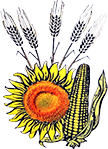Identification of Valuable Germplasm Sources for the Creation of Soybean Varieties with High Yield Quality
Camelia Urdă1, Raluca Rezi1, Adrian Negrea1,2, Luana Păcurar1, Ramona Dina Galben2
1Staţiunea de Cercetare-Dezvoltare Agricolă Turda
2Universitatea de Ştiinţe Agricole şi Medicină Veterinară Cluj-Napoca
Keywords: soybean, variability, quality, germplasm, breeding.
Abstract: To improve the Romanian soybean genetics, continuous research is required in order to create varieties suitable for processing industry as raw material and also to meet the market demands.
This is the priority objective of the soybean breeding program at Research and Development Station for Agriculture Turda (ARDS Turda). The existence of a genetic variability in the germplasm, allows the continuation of genetic progress through classical breeding, using conventional hybridization and selection methods, along with chemical and biochemical analyzes. In order to improve the quality of soybeans, first step consist in the evaluation of the existing biological material. Thus, in the laboratory, in an experiment carried out over a period of three years, using near-infrared spectrophotometric analysis, a non-destructive control of seed quality was performed on 140 soybean genotypes. In the future, the aim is to create soybean varieties with a higher thousand kernel weight, light hilum and an improved chemical composition, especially by increasing the protein and oil content and also an improved profile of fatty acids.
Thus, in this experiment, protein content, fat content and four fatty acids (stearic, oleic, linoleic and linolenic) responsible for the quality and stability of the oil were determined. The studied biological material originated from different ten countries on two continents: Romania, Switzerland, Italy, Poland, France, Austria, Hungary, Serbia, Germany, China. The identification of positive correlations between the analyzed characters helps the selection within the breeding program, while the existence of negative correlations between the analyzed quality parameters makes it difficult to improve them simultaneously.
Based on the experimental results, from the score diagram and cluster analysis it is observed that the 140 genotypes were grouped in pairs and did not form clusters, indicating a high variability that allows the simultaneous or separate improvement of the analyzed quality indices. The analysis of the principal component was performed for all the characters studied, the obtained model explains 99% of the variance.
This model confirm the Person coefficients and expose close positive or negative links between the studied features. The cluster analysis indicates that the experimented biological material has high variability, allowing the successful improvement of the quality of soybeans by the correct choice of genitors.
